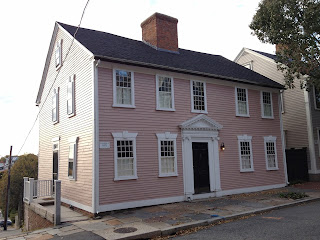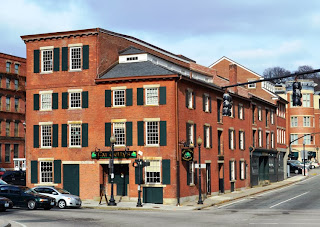 |
| Seril Dodge House, Thomas St., Providence. |
Gorham was a name I always knew. I picked out my silver pattern when I was 12; "Celeste" was a brand-new pattern that year, and I think I saw the ad for it in
American Girl magazine. My folks would give me a few pieces in my stocking every year, and wedding gifts finished the set for me. (I'd never pick out this pattern today--it looks very Disney/early space adventure to me now!!)
My Mom's silver was Gorham too. The "Lyric" pattern was introduced in 1940, so it was still a new pattern when she was married during the war in 1944.
This all came rushing back to me during the past month while I researched the history of Gorham for a special walking tour I conducted (along with two other guides) last Saturday. It was cosponsored by the Rhode Island Historical Society and the Rhode Island School of Design (RISD) Museum, and we visited both locations plus a number of stops in between.
To tell the story of Gorham, we need to go back to 1784 when two men named Seril and Nehemiah Dodge moved from Connecticut to Providence. They were either half-brothers, or uncle and nephew, and they are credited with developing the process of electroplating--depositing a thin layer of gold or silver on copper. Keeping in mind that only the well-to-do could afford jewelry made of pure silver and gold, the Dodges were able to make jewelry that could be sold to a wider audience.
Seril built two houses on Thomas Street in Providence in the late 1780s and early 1790s; both are still standing and now part of the Providence Art Club. He returned to Connecticut in 1796, but Nehemiah stayed in Providence. He opened a shop on Main Street, and he advertised his business in 1798 as selling "gold necklaces, knobs and twists, gold rings, miniature cases, and fine jewelry."
 |
| Jabez Gorham House, 56 Benefit Street, Providence. |
Nehemiah lived at 65 Benefit Street, a few blocks from his shop. (The house is no longer there; a different house was moved to that location some years ago.) Across the street, at 56 Benefit, lived the Gorham family.
Jabez and Caty Gorham had eight children--their fifth child, born in 1792, was called Jabez like his father, grandfather, and great-great-grandfather before him. When young Jabez was 10 years old, his father died. This must have created financial pressure on the family, and at 14 Jabez was indentured as an apprentice to his neighbor, Nehemiah Dodge, to learn jewelry making.
 |
| 3 Steeple Street, Providence. |
In 1813, when Jabez completed the seven years of his apprenticeship, he opened a partnership with four other young men to make jewelry. Their firm (called "The Firm") was located in a building that no longer exists--the location is a parking lot at the corner of North Main and Steeple Streets. But the building must have looked much like the 1793 building that sits at the other end of Steeple Street (#3).
The Firm prospered for a few years, but hit a snag in 1818 and the partnership dissolved. However, Jabez Gorham stayed in business at the same location, operating under the name Jabez Gorham, Jeweler.
In the 1820s, with his business expanding, Jabez moved across the street to #12 Steeple. He was one of the first to manufacture what was called "French Filigree" jewelry, competing successfully with imported goods. He also designed a special kind of gold chain which became known as "The Gorham Chain." He sold goods from his shop on Steeple Street, and through peddlers--the manufacturer's reps of the day. He also traveled throughout New England and New York on sales trips himself. So he was a manufacturer, a retailer, a traveling salesman, and a sales manager--all at the same time!
 |
| Gorham coin silver spoon, ca. 1845. |
In 1831, Jabez took on Henry Webster (a Boston silversmith) and the new Gorham & Webster operation started making coin silver spoons. These spoons had begun to replace pewter spoons in households throughout the eastern U.S. The spoons were very thin in order to keep costs down and make them affordable. (To give you a feeling for how thin, the average Gorham sterling spoon in the modern era weighs about two and a half times a coin silver spoon.)
1831 is considered to be the year that Gorham Silver was founded.
(to be continued)
Illustration Credits and References
Jabez Gorham house photo by the author.
3 Steeple Street photo from the
Carlisle Wide Plank Floors website.
Gorham coin silver photo by Replacement Sterling 925 on eBay.
An exhaustive history of Gorham can be found in the book
Gorham Silver by Charles H. Carpenter, Jr. (Revised edition published by Alan Wofsy Fine Arts, San Francisco, 1997.)




